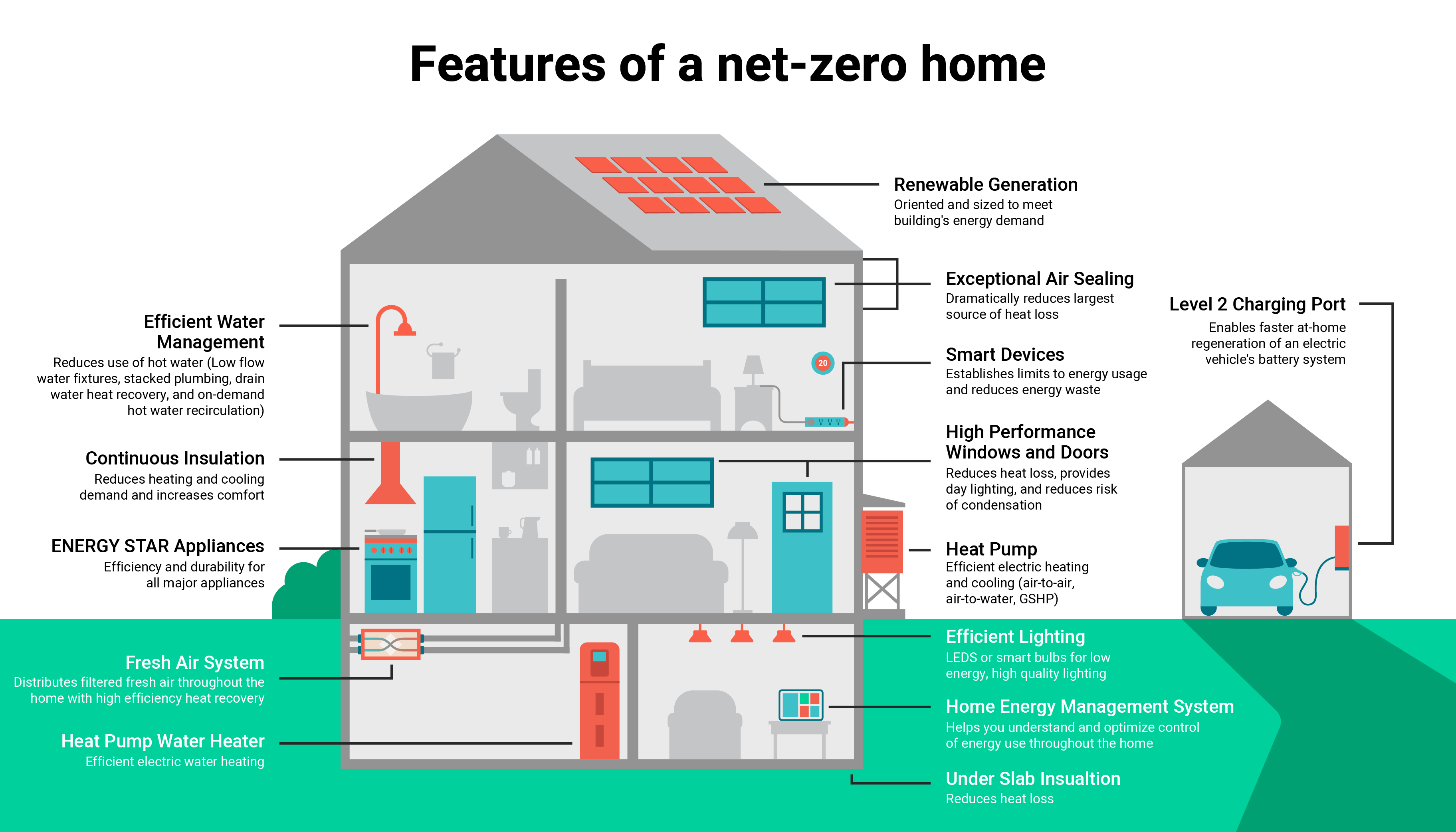The end goal of Canada’s 2020 national model codes is that all new buildings will be built to net-zero energy-ready standards by 2030, a commitment the federal, provincial, and territorial governments, in consultation with Indigenous stakeholders, outlined in the 2016 Pan-Canadian Framework on Clean Growth and Climate Change (PCF).
Read on for an overview of what net-zero energy (NZE) and net-zero energy ready (NZEr) buildings are, the benefits these buildings can provide, and how NZE/NZEr can be achieved.
What is a net-zero energy ready building?
A net-zero energy (NZE) building can produce as much clean energy as it consumes. According to Natural Resources Canada, they are expected to be 80% more energy efficient than a new building constructed to today’s building code minimum. They use on-site (or near-site) renewable energy systems to produce the remaining energy they need.
A net-zero energy ready (NZEr) building is designed, modelled and constructed the same as one that is NZE but does not yet have on- or off-site renewable energy components in place.
A core aspect of net-zero energy “readiness” is improved air sealing, increased insulation levels, and high-performance windows and doors to reduce thermal demand and facilitate appropriately sized space and water heating equipment.

Source: Adapted from Efficiency Vermont
The benefits of NZE/NZER buildings
In Canada, less than 1% of buildings can be considered NZEr. We need to quickly scale up the number of NZEr buildings constructed each year through the adoption of ambitious NZEr building codes.
Not only will this help reach our global climate commitments, but it will also have the benefit of generating investments in our buildings sector while offering good, local jobs in the clean economy for all Canadians.
A NZE or NZEr building also provides several benefits including the following:
Energy savings
Smart design with energy as an early consideration means less energy is used to keep your home warm in the winter and cool in the summer. This often leads to lower energy bills that help offset any increased costs from additional energy efficiency measures.
Healthier indoor air quality
Rather than relying on a leaky building envelope that allows contaminants, uncontrolled moisture, and unconditioned air, airtight NZE/NZEr buildings use Energy Recovery Ventilators (ERV) or Heat Recovery Ventilators (HRV) to supply fresh air without wasting energy.
Resilience
NZE/NZEr buildings are better able to withstand extreme weather disruptions and provide refuge during periods of shocks such as a prolonged power outage. They also can maintain a livable temperature longer thereby keeping occupants safe in extreme weather.
Greater comfort
Strategic placement of the building, windows and overhangs, and increasing the airtightness of the building make a NZE/NZEr building less drafty, quieter and less prone to uncomfortable temperature swings.
Higher resale and rental value
NZE/NZEr buildings command a market premium not only for their increased comfort or lower energy bills but also because they are more durable.
Smaller ecological footprint
Fewer greenhouse gas emissions and reduced energy use are clear benefits. A more thoughtful design can also result in fewer resources used in the construction of your NZE/NZEr building.
High-performance building basics
NZE and NZEr buildings are typically achieved through improvements to the building envelope that reduce the overall energy consumed in the building. Measures such as more insulation or better-performing windows also provide enhanced comfort to building occupants, as well as greater durability of the structure and increased resilience in the event of power outages, forest fires or other catastrophic events.
A common misperception is that these measures are unnecessary given the proliferation of low-cost renewable energy. Renewables do play an important role in reaching NZE buildings but only after energy loads have been drastically reduced through energy efficiency measures such as those described above.
Advanced energy codes such as the 2020 national model codes typically take an “envelope-first” approach that emphasizes increased airtightness levels, increased insulation, better-performing windows, or more efficient HVAC equipment.
The benefits of this approach include:
- Improvements to the long-term durability of the buildings
- Healthier and more comfortable indoor environment
- Lower energy demands over the life of the building
- Right-sized efficient, heating and cooling equipment can be used which can lead to lower equipment costs
- The building will be less likely to require costly retrofits in the future
Building on these measures, building owners and occupants can reduce the energy waste in their buildings by selecting and using low-energy lighting, such as LEDs, and better-performing ENERGY STAR® appliances and equipment.
10 steps towards achieving NZE or NZEr
Integrated Design Process (IDP) takes a holistic and collaborative approach to building design and construction by bringing together all members of the building ecosystem to optimize the house as a system.
Passive design strategies such as building orientation, optimized window selection and shading lower the building’s energy consumption.
Energy modelling in the design phase helps to balance building performance with cost considerations.
Build it tight, ventilate right is an approach to making the building envelope airtight while providing balanced, whole house ventilation. A continuous source of fresh filtered air and moisture control is critical to a safe, healthy, and comfortable building.
Optimized insulation levels for the floors, walls and ceiling and reduced thermal bridging keeps the heat in.
Window and doors selected for their performance and optimized for size and orientation help to control thermal losses and create a more comfortable environment.
Energy efficient and right-sized heating, ventilation, and air conditioning equipment, such as an Air Source Heat Pumps reduce energy use and emissions.
Energy efficient hot water heating equipment located near where it is needed lowers energy use and minimizes heat loss.
Energy efficient lighting and appliances such as EnergyStar® rated equipment leads to lower operating energy demands.
Take advantage of reduced energy loads and add renewable energy such as solar photovoltaics (PV).

